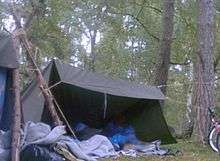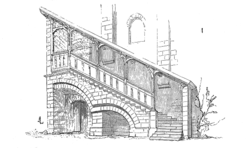Lean-to

A lean-to is a type of simple structure originally added to an existing building with the rafters "leaning" against another wall. Free standing lean-to structures are generally used as shelters. One traditional type of lean-to is known by its Finnish name laavu.
Lean-to buildings

A lean-to is originally defined as a building in which the rafters lean against another building or wall, a penthouse.[1]
A lean-to shelter is a free standing structure with only three walls and a single-pitched roof. The open side is commonly oriented away from the prevailing winds and rains. Often it is a rough structure made of logs or unfinished wood and used as a camping shelter. Temporary structures made from wood or textiles are also termed lean-to's if constructed with a single slope of the roof. In some cases the sloping roof extends all the way to the ground thus the roof itself forms the rear "wall".
A lean-to addition is a shed with a sloping roof and three walls that abuts the wall of another structure. This form of lean-to is generally provisional; it is an appendix to an existing building constructed to fulfill a new need. Sometimes they cover external staircases, as is the case with the lean-to building built in the 15th century against one of the walls of the large chapter room of the cathedral of Meaux. Sometimes, they are built to protect entrances or to establish covered markets around certain large civic buildings.[2]
Laavu


A Finnish laavu, Swedish gapskjul or slogbod, or Norwegian gapahuk is also a traditional, ethnic lean-to, small building intended for temporary residence during hiking or fishing trips in the wilderness.
Laavus are commonly found in Finnish Lapland near popular fishing rivers and in national parks. In principle, a laavu is a simplified version of a wilderness hut. Like wilderness huts, laavus are not kept warm, and may not be reserved beforehand. Unlike wilderness huts, laavus lack doors or windows. A typical laavu is a wooden building, about 10 m² in area and 2 m high, consisting of a roof, floor, and three walls. The fourth wall is left permanently open.
A laavu is intended to only provide a safe place to sleep during fishing or hiking trips. Visitors are expected to bring their own sleeping bags, as there are no other sleeping facilities. Most laavus also have a place to hold a campfire in front of them, but the laavu is built such that a reasonable fire cannot provide warmth for the night.
A laavu can also be an improvised structure of the same fashion built out of available materials (branches with leaves or pine/fir needles intact or moss or pelts for the covering and sturdier stripped branches or young tree-trunks as the supporting structure) for temporary camp deep in the wilderness, even for a single overnight stay. This is the traditional meaning of the word. Traditionally a log fire was used, made such that it did not need surveillance during the night ("rakovalkea" in Finnish, "nying" in Swedish and Norwegian).
In the United States this same type of structure is commonly referred to as an "Adirondack". Many youth camps use such structures to provide an inexpensive shelter for campers that is sturdier, and more durable, than a textile tent.

Laavus made of tent cloth are also sold, meant for four or five people. They are lighter than tents and can be warmed by a camp fire. Some of the modern nylon laavus have a front wall that is pulled down for the night if fire is not to be kept.
References
- ↑ "Lean-to" def. A. Oxford English Dictionary Second Edition on CD-ROM (v. 4.0) © Oxford University Press 2009
- ↑ Dictionary of French Architecture from 11th to 16th Century (1856)
External links
 Media related to lean-to at Wikimedia Commons
Media related to lean-to at Wikimedia Commons
